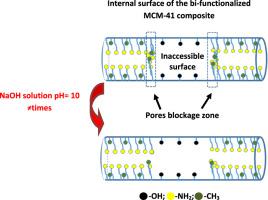当前位置:
X-MOL 学术
›
Solid State Sci.
›
论文详情
Our official English website, www.x-mol.net, welcomes your feedback! (Note: you will need to create a separate account there.)
MCM-41-based composite with enhanced stability for Cr(VI) removal from aqueous media
Solid State Sciences ( IF 3.5 ) Pub Date : 2020-08-01 , DOI: 10.1016/j.solidstatesciences.2020.106300 Pedro Martin , Matías Rafti , Sergio Marchetti , Nicolas Fellenz
Solid State Sciences ( IF 3.5 ) Pub Date : 2020-08-01 , DOI: 10.1016/j.solidstatesciences.2020.106300 Pedro Martin , Matías Rafti , Sergio Marchetti , Nicolas Fellenz

|
Abstract Two mesoporous ordered silica with MCM-41 pores arrangement were synthesized and surface modified by a post-synthetic treatment. The first composite has aminopropyl functionalities while the other features aminopropyl and methyl surface groups. Both composites were used as sorbents for Cr(VI) removal from aqueous media at pH ꞊ 2. In order to test the stability and durability of the sorbents, the samples were subjected to alkaline extreme conditions (pH ꞊ 10) at different times and after that tested again for Cr(VI) removal. The bi-functionalized MCM-41 retains its Cr(VI) elimination capacity unchanged after 16 h of alkaline treatment, while the aminopropyl-MCM-41 sample suffer a drop of about 30%. The fresh and alkaline treated samples were characterized by X ray diffraction at low angles, nitrogen sorption at 77 K, Fourier transform infrared, Thermal analysis. The presence of the methyl moieties increases the hydrophobicity of the composite's surface, which inhibit the approaching of the water molecules avoiding the hydrolysis of Si–O–Si bonds of the MCM-41 pores walls. Besides, this protective effect is reflected in the textural properties changes before and after alkaline treatments: while the specific surface area of aminopropyl-MCM-41 goes from an initial value of 793 to 495 m2 g−1 (−37.6%), the aminopropyl-methyl-MCM-41 shows a change from 702 to 650 m2 g−1 (−7.2%). From these results it can be concluded that a second functionalizing agent that expose methyl-residues increases the stability of an aminopropyl-MCM-41 based-material, increasing the potential of this type of nanostructured composites for aqueous media applications.
中文翻译:

具有增强稳定性的 MCM-41 基复合材料,可从水介质中去除 Cr(VI)
摘要 合成了两种具有MCM-41孔排列的介孔有序二氧化硅,并通过合成后处理进行了表面改性。第一种复合材料具有氨基丙基官能团,而另一种复合材料具有氨基丙基和甲基表面基团。两种复合材料均用作吸附剂,用于在 pH ꞊ 2 下从水性介质中去除 Cr(VI)。为了测试吸附剂的稳定性和耐久性,将样品在不同时间和之后经受碱性极端条件 (pH ꞊ 10)再次测试了 Cr(VI) 的去除。双官能化的 MCM-41 在碱处理 16 小时后仍保持其 Cr(VI) 消除能力不变,而氨丙基-MCM-41 样品则下降约 30%。新鲜和碱处理过的样品通过低角度的 X 射线衍射、77 K 的氮吸附、傅里叶变换红外,热分析。甲基部分的存在增加了复合材料表面的疏水性,这抑制了水分子的接近,从而避免了 MCM-41 孔壁的 Si-O-Si 键的水解。此外,这种保护作用还体现在碱处理前后质构特性的变化上:氨基丙基-MCM-41 的比表面积从初始值 793 增加到 495 m2 g-1 (-37.6%),而氨基丙基-MCM-41 的比表面积从初始值 793 -甲基-MCM-41 显示从 702 到 650 m2 g-1 (-7.2%) 的变化。从这些结果可以得出结论,暴露甲基残基的第二种官能化剂增加了基于氨基丙基-MCM-41 的材料的稳定性,增加了这种类型的纳米结构复合材料在水性介质应用中的潜力。甲基部分的存在增加了复合材料表面的疏水性,从而抑制了水分子的接近,从而避免了 MCM-41 孔壁的 Si-O-Si 键的水解。此外,这种保护作用还体现在碱处理前后质构特性的变化上:氨基丙基-MCM-41 的比表面积从初始值 793 增加到 495 m2 g-1 (-37.6%),而氨基丙基-MCM-41 的比表面积从初始值 793 -甲基-MCM-41 显示从 702 到 650 m2 g-1 (-7.2%) 的变化。从这些结果可以得出结论,暴露甲基残基的第二种官能化剂增加了基于氨基丙基-MCM-41 的材料的稳定性,增加了这种类型的纳米结构复合材料在水性介质应用中的潜力。甲基部分的存在增加了复合材料表面的疏水性,从而抑制了水分子的接近,从而避免了 MCM-41 孔壁的 Si-O-Si 键的水解。此外,这种保护作用还体现在碱处理前后质构特性的变化上:氨基丙基-MCM-41 的比表面积从初始值 793 增加到 495 m2 g-1 (-37.6%),而氨基丙基-MCM-41 的比表面积从初始值 793 -甲基-MCM-41 显示从 702 到 650 m2 g-1 (-7.2%) 的变化。从这些结果可以得出结论,暴露甲基残基的第二种官能化剂增加了基于氨基丙基-MCM-41 的材料的稳定性,增加了这种类型的纳米结构复合材料在水性介质应用中的潜力。
更新日期:2020-08-01
中文翻译:

具有增强稳定性的 MCM-41 基复合材料,可从水介质中去除 Cr(VI)
摘要 合成了两种具有MCM-41孔排列的介孔有序二氧化硅,并通过合成后处理进行了表面改性。第一种复合材料具有氨基丙基官能团,而另一种复合材料具有氨基丙基和甲基表面基团。两种复合材料均用作吸附剂,用于在 pH ꞊ 2 下从水性介质中去除 Cr(VI)。为了测试吸附剂的稳定性和耐久性,将样品在不同时间和之后经受碱性极端条件 (pH ꞊ 10)再次测试了 Cr(VI) 的去除。双官能化的 MCM-41 在碱处理 16 小时后仍保持其 Cr(VI) 消除能力不变,而氨丙基-MCM-41 样品则下降约 30%。新鲜和碱处理过的样品通过低角度的 X 射线衍射、77 K 的氮吸附、傅里叶变换红外,热分析。甲基部分的存在增加了复合材料表面的疏水性,这抑制了水分子的接近,从而避免了 MCM-41 孔壁的 Si-O-Si 键的水解。此外,这种保护作用还体现在碱处理前后质构特性的变化上:氨基丙基-MCM-41 的比表面积从初始值 793 增加到 495 m2 g-1 (-37.6%),而氨基丙基-MCM-41 的比表面积从初始值 793 -甲基-MCM-41 显示从 702 到 650 m2 g-1 (-7.2%) 的变化。从这些结果可以得出结论,暴露甲基残基的第二种官能化剂增加了基于氨基丙基-MCM-41 的材料的稳定性,增加了这种类型的纳米结构复合材料在水性介质应用中的潜力。甲基部分的存在增加了复合材料表面的疏水性,从而抑制了水分子的接近,从而避免了 MCM-41 孔壁的 Si-O-Si 键的水解。此外,这种保护作用还体现在碱处理前后质构特性的变化上:氨基丙基-MCM-41 的比表面积从初始值 793 增加到 495 m2 g-1 (-37.6%),而氨基丙基-MCM-41 的比表面积从初始值 793 -甲基-MCM-41 显示从 702 到 650 m2 g-1 (-7.2%) 的变化。从这些结果可以得出结论,暴露甲基残基的第二种官能化剂增加了基于氨基丙基-MCM-41 的材料的稳定性,增加了这种类型的纳米结构复合材料在水性介质应用中的潜力。甲基部分的存在增加了复合材料表面的疏水性,从而抑制了水分子的接近,从而避免了 MCM-41 孔壁的 Si-O-Si 键的水解。此外,这种保护作用还体现在碱处理前后质构特性的变化上:氨基丙基-MCM-41 的比表面积从初始值 793 增加到 495 m2 g-1 (-37.6%),而氨基丙基-MCM-41 的比表面积从初始值 793 -甲基-MCM-41 显示从 702 到 650 m2 g-1 (-7.2%) 的变化。从这些结果可以得出结论,暴露甲基残基的第二种官能化剂增加了基于氨基丙基-MCM-41 的材料的稳定性,增加了这种类型的纳米结构复合材料在水性介质应用中的潜力。



























 京公网安备 11010802027423号
京公网安备 11010802027423号